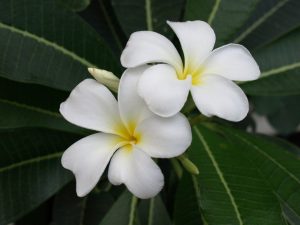Sorry for keeping you waiting. Go on now, give a read to all the trees left and add the knowledge to your hat.
List of Sacred Trees:
8. Banana (Musa acuminata)
Banana tree symbolizes Lord Vishnu and its fruit is offered to Goddess Lakshmi and Vishnu for a prosperous life. Conforming to ancient scriptures, the tree is regarded as Devaguru or planet Jupiter. As a matter of fact, banana is the only plant whose leaves, flower, fruit and stem have medicinal properties. Its leaves represent regeneration and growth and are tied to pillars, hung at the entrance to mark an auspicious occasion. They are also used as plates to serve food or prasad.
BENEFITS:
Banana peel
- The unripe banana peel has more antioxidants than a ripe banana which is due to the presence of ‘phenolics’.
- The ‘lutein’ present in the peel reduces oxidative stress and neutralizes free radicals in the body.
- Extracts of banana peel have anti-inflammatory properties. It is also enriched with bioactive compounds such as carotenoids and polyphenols.
- According to a 2015 study, banana peels have shown antimicrobial activity against P. gingivalis , the gingivitis causing bacteria .
- Peels can be added to soil to increase fertility.
Banana fruit
- Bananas are a rich source of vitamin B6 and manganese.
- The fruit is rich in iron, thus helpful for anaemic people.
- Keeps in check high blood pressure.
- It is Known as the brain tonic as it is rich in potassium and also maintains heart health.
- It helps neutralize acid in the stomach and provides relief from ulcers and improves digestive health.
Banana stem
- Heals gastric issues
- Aids in weight loss
- Detoxifies and improves digestion
Banana flower
- Supports menstrual wellness
- Controls diabetes
- Keeps infections at an arm’s length
- Prevents cancer and heart diseases
- Has anti-ageing power
- Its leaves and trunk are used to serve food and as welcoming gates respectively.
9. Sandalwood (Santalum album)
Sandalwood is widely used to manufacture perfumes and is also considered to be a holy and sacred tree. The wood is made into a paste which is considered pure and then used in worshipping Lord Shiva and Vishnu. This paste is used to decorate icons of deities and calm the mind during the prayer. It is distributed to devotees for applying on their forehead. It is also heard that Goddess Lakshmi lives in the sandalwood tree. Sandalwood oil has a soft, warm and precious-wood scent.
Sandalwood oil has been used with other therapies to manage:
- common cold
- urinary tract infections
- liver and gallbladder problems
- manage anxiety
- support wound healing
- guard against skin cancer
- fight bacteria
- digestive problems
- muscle problems
- hemorrhoids
- scabies
10. Parijaat tree, Kintoor (Nyctanthes arbor-tristis)
This tree is said to be found in Kintoor, Uttar Pradesh and is estimated to be 1000 to 5000 years old. This unique tree is believed to have been brought by Krishna from heaven. 
Parijaat is associated with Mahabharata and is heard to be growing on Kunti’s ashes.
11. Plumeria (Plumeria rubra)
Plumeria is the symbol immortality as it blooms even after being uprooted. It is considered to be one of the holiest of trees amongst Hindus and is planted near temples. It is sacred to the God of Love, Kamadeva. It is also called Indian magnolia, frangipani and champa.
Health Benefits of Frangipani essential oil:
- Maintains a healthy skin
- Lowers headache
- Has Antioxidant activity
- It is used as a remedy for diarrhoea and itch in India.
- Bark is used for fever, hard tumors and gonorrhoea.
- Shoots and flowers are used to treat Malaria.
12. Tulsi (Ocimum tenuiflorum)
The holy basil is respected, used as an immunity booster and is one of the best herbs available for medicinal purposes. The leaves of this easily available plant are rich in phytonutrients, Eugenol (a bioactive compound that has anti-microbial, anti-fungal and anti-bacterial properties and reduces stress and plasma glucose levels, vitamins, and minerals. Recent studies have indicated that this sacred tulsi can help slow down the growth of HIV cells and inhibit development of certain carcinogenic cells. It protects you from cold, cough and viral infections too.The leaves can be infused with the morning tea.
Recent studies have indicated that this sacred tulsi can help slow down the growth of HIV cells and inhibit development of certain carcinogenic cells. It protects you from cold, cough and viral infections too.The leaves can be infused with the morning tea.
13. Kadamb (Neolamarckia cadamba)
It is believed that Goddess Durga resides in the Kadamba forest. Also, lord Krishna carried out his childhood activities and played flute under this tree.
Karam-Kadamba is a famous harvest festival, celebrated on the eleventh lunar day of the Bhadra month. A twig from this tree is brought home and worshipped in the courtyard . Later in the day, young ears of grain which are the fruit-bearing spike of a cereal, are distributed among the loved ones.
BENEFITS:
- The inflorescences and fruit of the sacred Kadamb can be consumed by humans.
- The fresh leaves are fed to cattle.
- The extract of the leaves are used as a mouth gargle.
- ‘Attar’, an Indian perfume obtained from Kadamba flowers.
- It sheds large amounts of leaf and non-leaf litter which improves soil quality on decomposition.
14. Kunda ( Jasminum multiflorum)
Kunda gets its beauty from the beautiful white flowers and is sacred to Vishnu. The flowers (star jasmine)are used in many religious ceremonies and worship of gods and goddesses in Manipur. It is an essential part of the marriage ceremonies and the flowers are used as garlands in the ceremony. 
Its aromatic flower is commonly used in perfumes and incense sticks.
15. Cannabis (Cannabis sativa)
Cannabis, commonly called bhang (a mixture of buds, leaves and flowers of female cannabis plant), consumption has been an age old tradition in Hindu religion. Its mention has been found in Hindu texts also. It is associated with lord Shiva and is considered to be sacred. It is distributed as prasad during the popular Hindu festival called Shivratri and Holi and is offered to Shiva. It is mixed with nuts, spices and boiled with milk or rolled into balls for consumption. But, mythology does not encourage Shiva worshippers to get high and also there is no textual evidence for this.
Bhang finds its uses in various ayurvedic medicines. Below given are some of its benefits:
- Reduces stress and anxiety
- Treats digestion related issues
- Treats nausea, vomiting and fever
- May reduce pain
The takeaway of Sacredness
Trees are worshiped for what is revealed or signified through them or for being abode of some supreme power.
Mother nature and its elements have their own value and benefits. They are worthy of respect and care. The trees or plants which are associated with gods should not be considered sacred alone but also the non-historical greens should be considered sacred. So, plant a tree and give back to nature for its unconditional love.
Do share more remedies and valuable information in the comment box.

